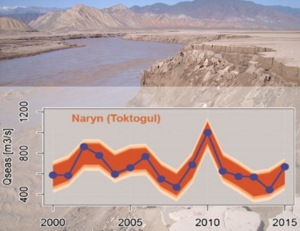Snow cover monitoring and seasonal runoff forecast
MODSNOW – An Operational Tool for Snow Cover Monitoring
Nowadays, snow cover infor-mation of high temporal and moderate spatial resolution can be obtained from optical remote sensing imagery, e.g. from MODIS products. Such information is valuable for the assessment of the status quo water storage in the mountains of Central Asia.
However, processing of such data is time consuming and not straightforward.
The user-friendly MODSNOW tool offers the possibility of auto-matically processing MODIS snow cover data for pre-defined river basins or a selected region.
The processing includes the data download, the elimination of clouds from the images, the derivation of daily snow cover maps as well as basin-wide and elevation dependent snow
cover statistics.
The tool may be set up in ope-rational mode with automated daily updates of snow cover information.
The non-operational mode may be used for deriving historical time series of snow cover information.
The resulting spatio-temporal information on snow cover can be used for seasonal water availability forecasting but also for scientific studies on climate and hydrological change.
Seasonal Precipitation and Runoff Forecast
A robust seasonal forecast of summer water availability is required in order to adapt the agricultural strategy to anoma-lous hydro-climatic conditions. For a quantitative prediction, state-of-the-art statistical forecast models have been developed, which relate ob-served hydro-climatological anomalies with suitable pre-dictor variables during prece-ding months. These forecast tools enable both, a determinis-tic forecast of water availability based on automatically selected covariates and an estimation of inherent uncertainties. For the prediction of summer runoff in various Central Asian catch-ments, snow cover rates (derived from the MODSNOW tool) as well as temperature and precipi-tation observations during winter have been found to be skillful predictors and explain
up to 80% of runoff variations.
With the aim of extending the lead time of runoff forecasts, similar models have been developed for the prediction of winter precipitation amounts. Large scale atmospheric and oceanic modes, particularly the El Niño and the Arctic Oscilla-tion, have been shown to signi-ficantly influence the Central Asian precipitation climate and various atmospheric indices have been identified as skillful predictor variables. Although uncertainties of climate predic-tions remain large, the modell-ing tool suggests that a certain degree of predictability exists already 6 months in advance.
The forecast tools are based on the free and open source environment R. Forecasting trainings for Central Asian experts have been conducted during the project period and the tools have been adjusted to
their operational needs.

